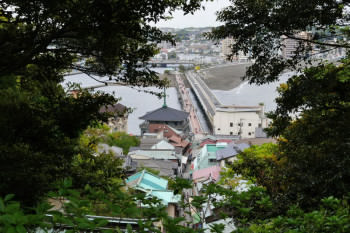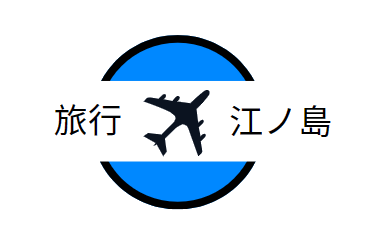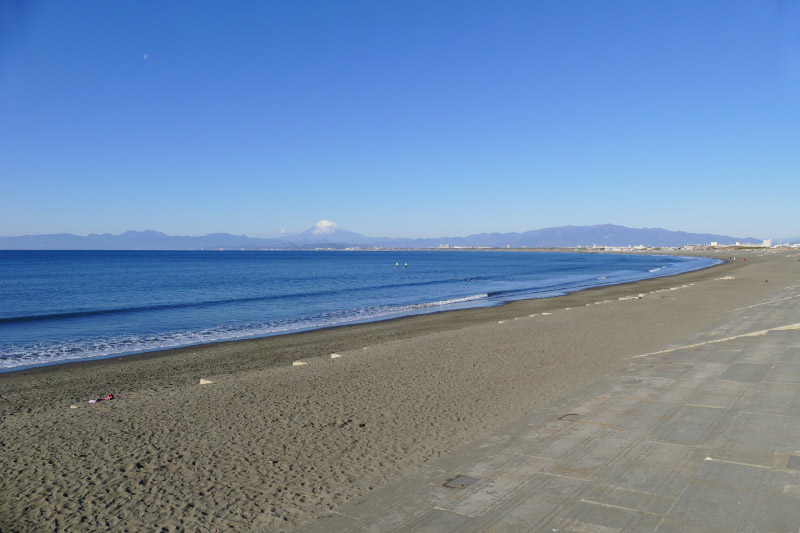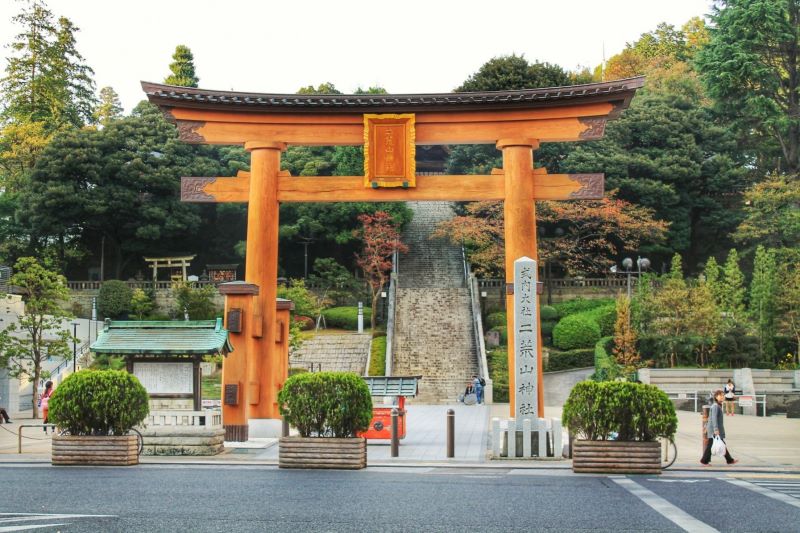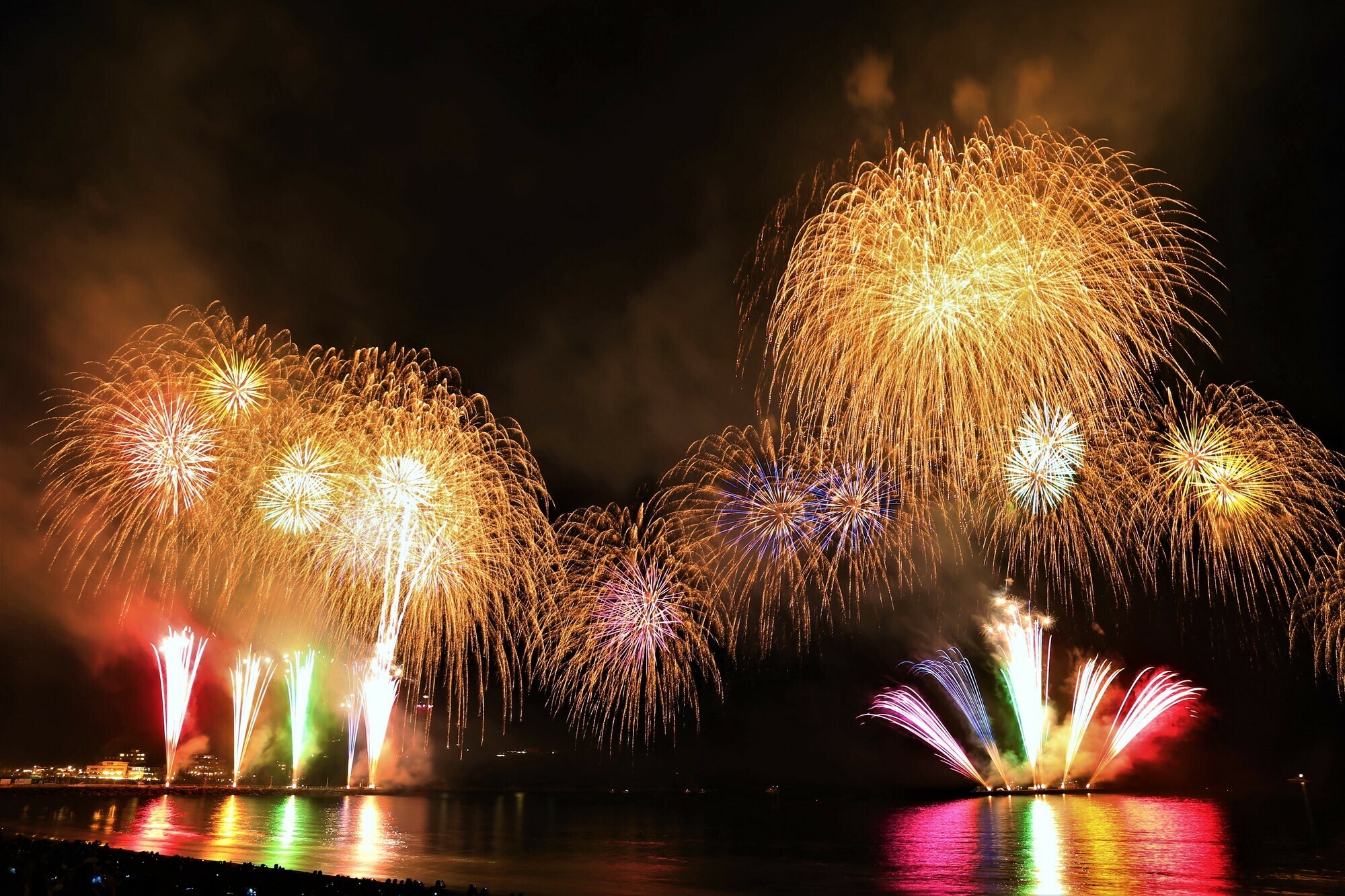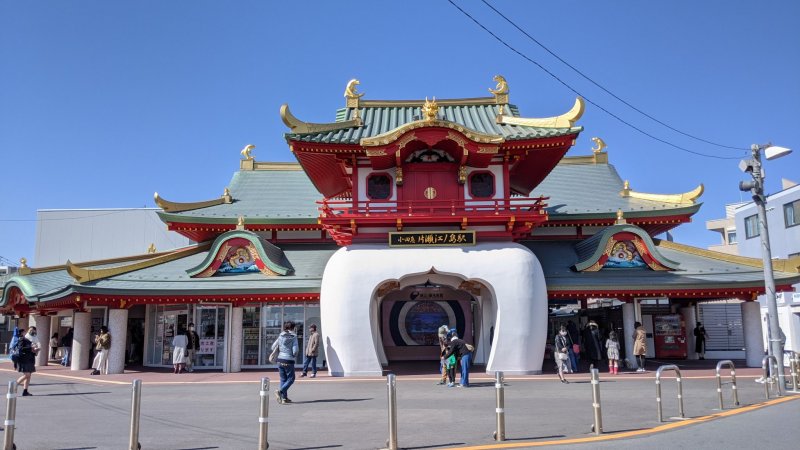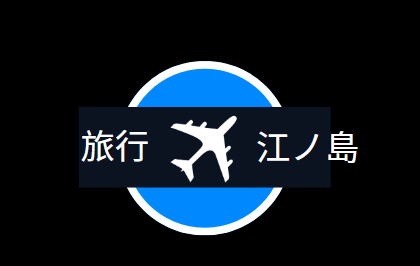江の島の総本宮
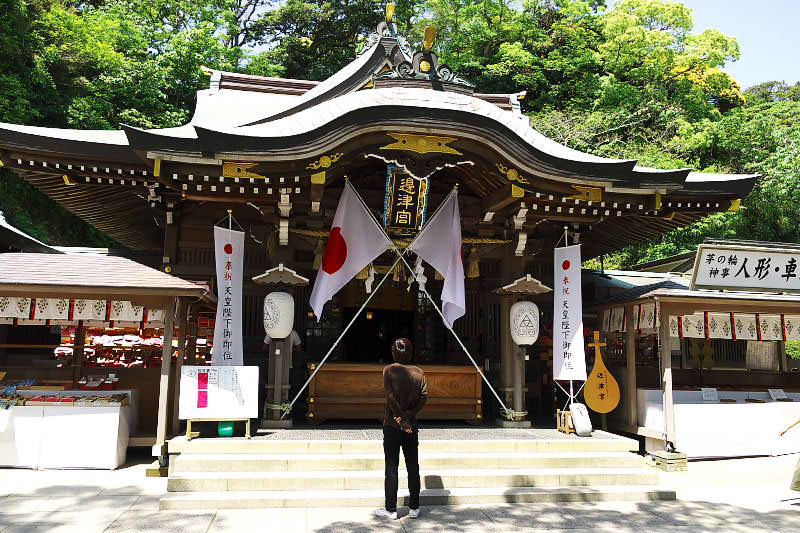
江島神社は島内の3つの神社から構成されており、その中で最大の神社がこの辺津宮本宮です。ここは江戸時代から江の島の信仰の中心地だった場所です。ここの弁財天を祀るのが江戸っ子の間でブームとなり、参拝者で賑わった。
江島神社観光ガイド
どこに行くか、何をするか?
- 辺津宮本宮参照。
- ドラゴンを探してみてください
- おみくじやその他の伝統的な宗教的アトラクションを体験してください
- 特におすすめなのは…あらゆるタイプの旅行者
どこまで?(辺津宮本宮まで徒歩)
- 片瀬江ノ島駅から20分(1.2km)
- 江ノ島駅から24分(1.5km)
- 湘南江の島駅から26分(1.6km)
- 赤い鳥居から辺津宮本宮まで5分(ずっと上り階段)
無料Wi-Fiスポット
- ここには無料Wi-Fiスポットはありません。
緊急の場合はこちらのページをご覧ください。
神社の神域に入る

仲見世通りの突き当たりに赤い大きな鳥居が立っています。ここは江島神社の神域の入り口であり、山頂への長い階段の出発点です。この赤い鳥居は1936年に再建されたもので、夜にはこの鳥居と赤提灯がライトアップされます。辺りは厳かな雰囲気に包まれます。


エスカルとは何ですか?
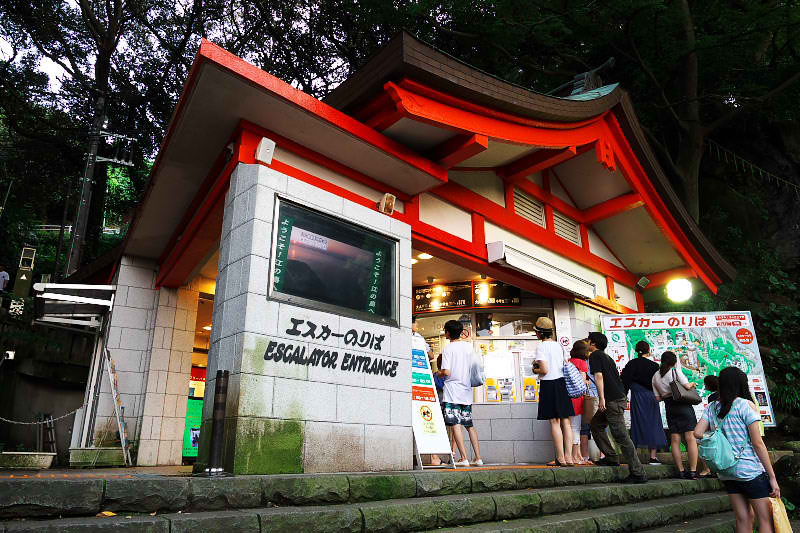
階段を上る自信がない場合は、有料エスカレーター「ESCAR」[エスカー]で行くこともできます。赤い鳥居の左側の赤い建物がチケット売り場と入口です。高低差46メートルの島の上にあるサムエル・コッキング苑前まで4つのエスカレーターで結ばれているエスカー。ただし、これは登りのみで、帰りは階段を下りる必要があります。
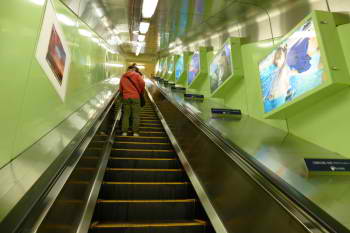
- [営業時間]毎日8:50~19:05(19:05)
- [運賃]
- 全区間:大人360円 / 小人180円
- 一日乗車券所持者割引運賃:大人320円 / 小人160円
※チケット購入時に「のりおりくん」「江の島・鎌倉フリーパス」「湘南モノレール1日フリーきっぷ」をご提示ください。
- 第一区間のみ(辺津宮本宮まで)
大人200円 / 小人100円
- 第2・第3セクターのみ(辺津宮本宮~島の頂上)
大人180円 / 小人90円
- 第三セクターのみ(中津宮~島の頂上)
大人100円 / 小人50円
随神門楼門
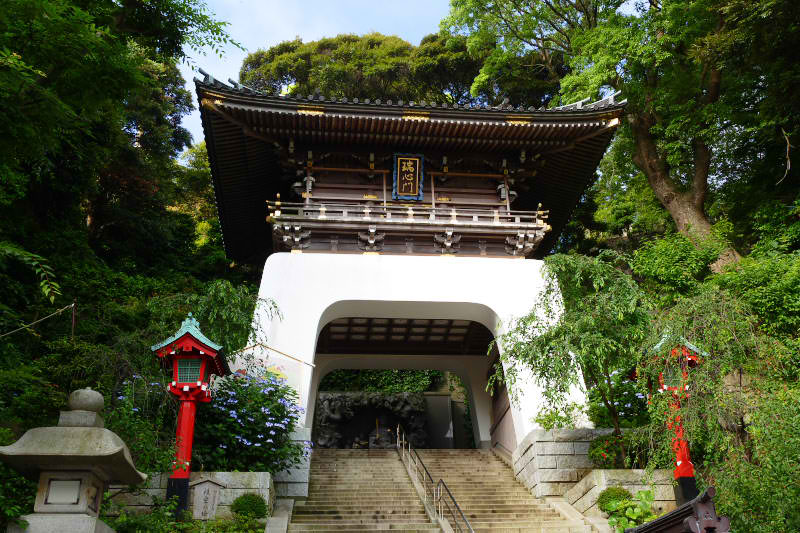
赤い鳥居をくぐると、階段の上に木造の楼門が見えてきます。こちらは
随心門 楼門です。昔話「浦島太郎」に登場する海底宮殿「龍宮城」をモデルにしたと言われています。この階段は正式な参拝道で、急な階段であることから
男坂と呼ばれています。
門の壁や天井には、牡丹の花や唐獅子などの美しい絵が数多く描かれています。このライオンは女神と崇拝者を守ります。門の階段の先には弁財天と龍の石レリーフがあります。この像は神社創建1450年を記念して建立されたものです。6月か7月にここを訪れたら、門の真下で振り返ってみてください。ここにはアジサイの花が咲いています。花の青と鳥居の赤のコントラストが美しいです。
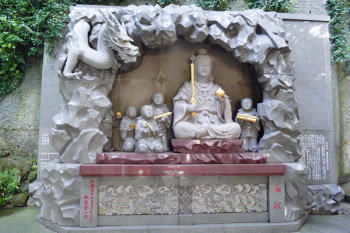

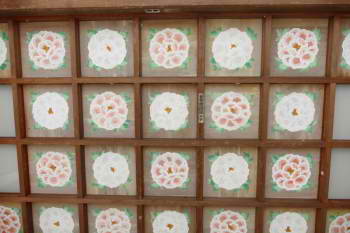
女坂坂道
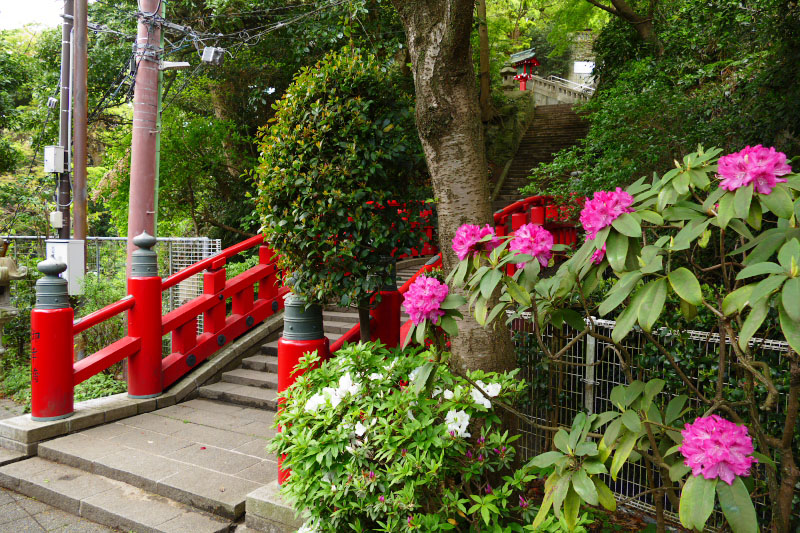
赤い鳥居をくぐり、すぐ右の道に進むと赤い橋が見えてきます。この道は女坂と呼ばれ、男坂よりも少し緩やかな坂です。赤い橋をくぐったら、右側の家の前まで道を登ります。右後ろに赤い橋へ行く別の道があります。赤い橋を渡ると随神門から階段を上ります。こちらへ行くと、ちょっと気になる随神門を迂回してしまいます。なので、帰りにはゲートを見るのを忘れずに!!
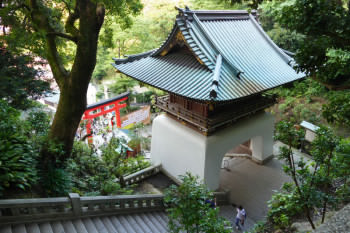
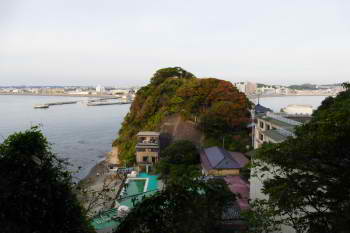
本宮「辺津宮」
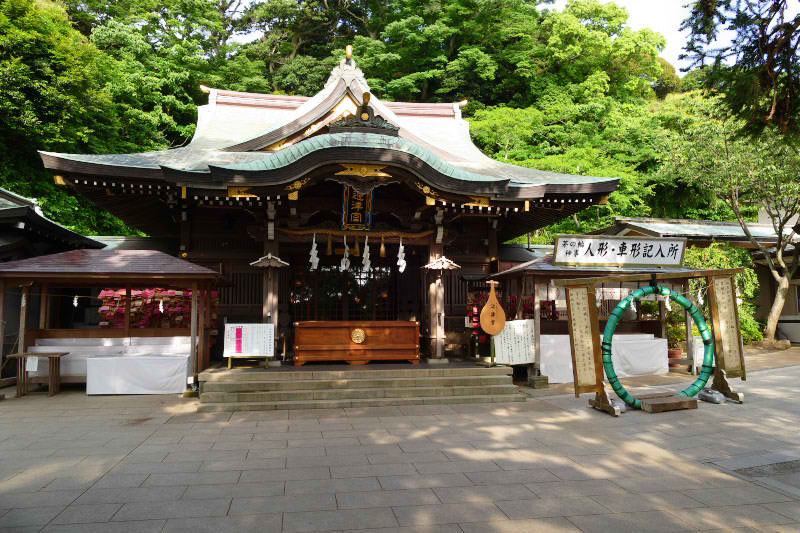
さらに階段を上がると、いよいよ社殿が見えてきます。ここが現在の江島神社の総本宮、辺津宮です。
- 【拝観時間】境内は終日拝観可能
- [入場無料
- 【公式サイト】※日本語のみ
建久2年(1206年)に鎌倉幕府三代将軍源実朝によって建立されました。現在の社殿は1976年に再建されたものです。
この神社は三姉妹の女神を祀っており、正面の扉の上にある木彫りの板にその姿を見ることができます。
参拝者を清めるために神社の前に設置される「茅の輪」。ホイールをくぐると浄化されます。
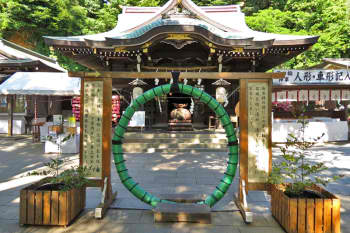
神社の前には巾着袋型の賽銭箱があります。日本では箱型のものが多いのでとても珍しいです。この賽銭箱は独特の彫刻が施されており、小銭を入れると音が鳴ります。
残念ながら、このユニークな賽銭箱は2017年に一般的な箱型のものに変更されてしまいました。しかし、神社には保存されており、祭りなどの時には社殿前に安置され、その独特の姿を見ることができるようです。
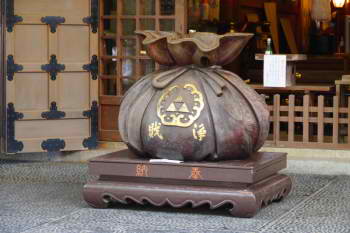
あなたは知っていますか?神社での参拝方法まずは社殿に向かう途中にある噴水で手を洗います。
社殿に到着したら賽銭箱の前に立ちます。
- まず賽銭箱に賽銭を入れます。
- 次に二回お辞儀をします。
- 次に、二回拍手をし、心の中で願い事を唱えます。
- 最後にもう一度お辞儀をします。
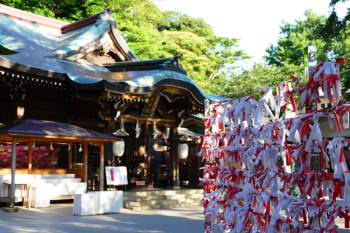
神社で は本殿の周囲で、各種おみくじや御守を販売しています。おみくじは、 近い将来の運勢やアドバイスを占う紙で、神社と仏閣にあります。もともとは、古代において重要な政治的決定を決定するために使用されていました。鎌倉時代には個人の運勢を占うようになりました。 基本的には日本語で表記されていますが、ここをはじめ一部の神社仏閣では多言語版(英語、中国語簡体字、中国語繁体字、韓国語)を用意している場合があります。おみくじの結果には大きく分けて6種類のランクがあります。
- 大吉 – 素晴らしい運気
- 中吉 – とても幸運です
- 吉 – 幸運を祈ります
- 小吉 – ちょっと幸運
- 末吉 – 不確実な運
- 凶 – 不運
凶が出た場合は、おみくじを境内の棚に縛り付けて放置する風習があります。しかし、近年は凶の割合が減少しているため、「凶」を喜ぶ人もいます。
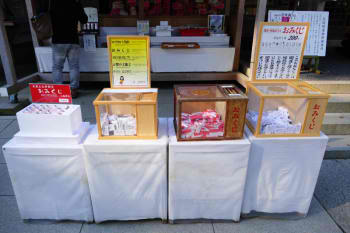
御守りは縁起物で、神社にも仏閣にもあります。
日本では布袋に包まれたお守りが一般的です。しかし、多くの神社やお寺では、動物や人形、伝統的な縁起物など、さまざまな形のお守りが販売されています。
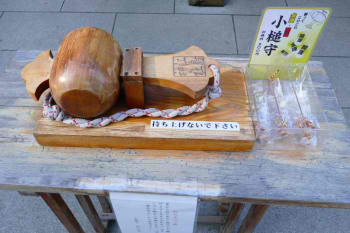
御朱印とは、神社や仏閣を参拝し、神仏とのご縁を証明するために授与される印章のことです。神社や寺院の名前とご本尊の名前を書道体で書きます。御朱印をいただくには300円~600円が必要です(神社・お寺によって金額は異なります)。「朱印帳」 と呼ばれる御朱印集めの手帳があり、近年では神社仏閣からさまざまなオリジナルデザインのものが販売されています。
本殿周辺
本殿の左側に赤い八角形の建物が見えてきます。奉安殿の建物で 、鎌倉時代に作られた裸の弁財天像が祀られています。
- 【営業時間】 8:30~16:30
【入場料】大人150円 - 高校生・中学生 100円
- 小学生50円。
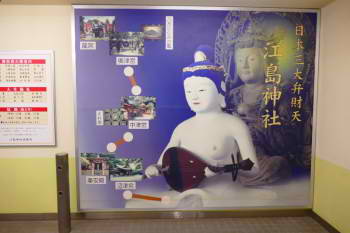
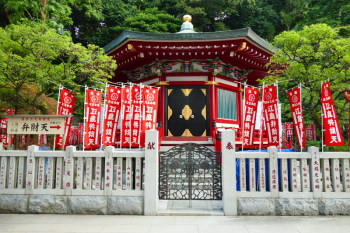
池からさらに進むと、ピンク色に覆われたラックが見つかります。神様に伝えたい願い事を書いた絵馬「絵馬」
です。辺津宮は特に縁結びにご利益があると言われています。
- 1個500円(祈祷料込み)
エマへの願い事を書き終えたら、エマラックのどこにでも掛けてください。
奥には白い龍神が佇む小さな池があります。鎌倉で有名な銭洗い弁天と同じように、この池でお金を洗うと何倍にもなって戻ってくるという伝説があります。
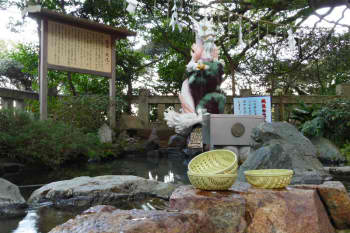
エマラック横の展望台からは、ここまで歩いてきた片瀬の町や弁天橋、仲見世通りが一望できます。さらに道を進むと鳥居があり、辺津宮本宮の境内を出る。ここを右折すると江島神社第二の中津宮を経由して山頂に行くことができます。
